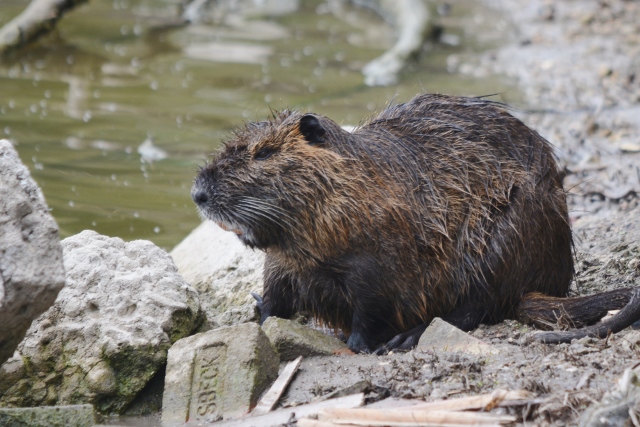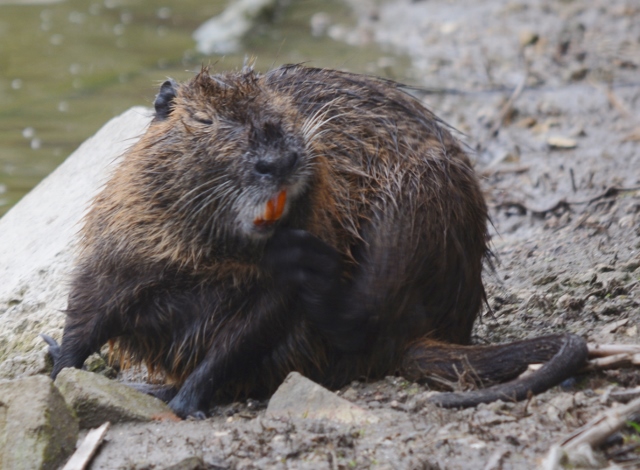
But, they’re so cute . . . .
By Anita Westervelt, Texas Master Naturalist
Looking much like a koala bear at first glance, these cute and cuddly-looking critters might be seen along the banks of resacas or irrigation ditches in the Rio Grande Valley.
They are nutria (Myocastor coypus). Native to South America, they are now found in at least 40 states and three Canadian provinces, and in Europe, Asia and Africa, thanks to a burgeoning fur trade at the end of the 1890s. The word nutria refers to the animal’s pelt, and has been adopted to denote the species in the states. Elsewhere they are called coypu, an Ancient Greek interpretation meaning beaver rat. The critters also are called river rats. They migrate via rivers.
As long as there is water nearby, nutria will hang around. They live in burrows that have openings below the water surface. They are semi-aquatic, wetland-dwelling rodents. They are omnivorous mammals, eating mainly vegetation and small creatures like snails and mussels.
Nutria can grow to two and a half feet long, not counting their tail, weigh from12 to 20 pounds and live up to 10 years.
Their most notable feature is their orange incisors. Three other distinguishing features are their hind feet, which consist of four webbed, clawed toes and one unwebbed toe; foot-long round, rat-like, nearly hairless tail; and white muzzle and whiskers.

Nutria’s hind legs are longer than their front which allows them to move swiftly overland for long distances when pursued. Underwater, they have the ability to see. They are strong swimmers, can swim long distances and remain submerged for as long as five minutes.
By the end of the 1940s, the fur trade tanked and the nutria were released into the wild. Initially, some state and federal agencies saw their release as a good thing — as a means of controlling vegetation.
However, the bad news about these animals quickly came to light. They can eat a quarter of their body weight in plant matter every day. They eat leaves, stems and roots. Their voracious eating habits destroy wetlands vegetation, land crops and residential lawns and gardens. Although nutria can be seen swimming during the day, they are most active between dusk and sunrise.
Their forepaws have five toes, four of which are clawed which allows the rodent to groom itself, and also to excavate roots and rhizomes as well as to make burrows in levees, dikes and embankments.
Their burrowing causes major erosion and eventual damage to natural and public flood control systems, banks and levees.
That’s not all, they are incredibly prolific. The female can have two to three litters a year, giving birth to five to 13 young each litter.
Nutria don’t have many natural predators. Birds of prey, like bald eagles and hawks, are a threat, as are garfish, dogs, turtles and alligators, according to a Google search about “what preys on nutria?” (https://animals.mom.me/preys-nutria-3586.html)
With all their negative traits, it’s no wonder nutria have been deemed an invasive species on nearly every continent.
To be fair, nutria can rid an overgrown resaca of cattails within a couple of years. They dive down and eat the heart of the plant. This is a good thing in that cattails are invasive, prolific and suck the water and life out of non-river-fed resacas, leaving only a dry depression in the earth. If nutria could be persuaded to tackle the dastardly underground system of giant Carrizo cane, (Arundo donax), Guinea grass (Urochloa maxima) and other invasive threats to the Valley’s native habitat and waterways, perhaps the rodents would partially redeem themselves.
Management options are listed at www.texasinvasives.org/animal_dadabase, including shooting as an “effective measure when environmental conditions force nutria into the open.” They note that night hunting is illegal in many states. Texas allows year-long harvesting in accordance with regulations at www.tpwd.gov.
In some countries nutria fur is still considered valuable and is used in manufacturing winter clothing. In Louisiana, where the rodents have created the majority of crops and flood-protection destruction, laws allow a hunting season where hunters can receive a bounty for nutria bodies. In addition, some groups are trying to popularize nutria’s lean meat by creating palatable recipes.
Nutria may be cute critters at first sight, but environmentally, there’s little to embrace.
